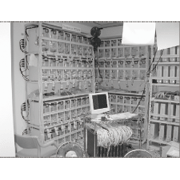Matsuoka Satoshi, working at the Tokyo Institute of Technology, developed a number of personal computer clusters for grid and cluster computer research with funding from the Japan Science and Technology Agency (JST). PRESTO II was the most powerful of these clusters. To verify the performance of PRESTO II, Matsuoka aimed to reach the Top 500 world ranking of supercomputers.
The following is a brief history of the clusters developed by the Matsuoka Lab.
- 1996 Cluster I 14 Sun SuperSPARC workstations Peak performance: 0.7 gigaFLOPS
- 1997 Cluster II 10 Pentium Pro computers Peak performance: 2 gigaFLOPS
- 1998 PRESTO I 64 Pentium II computers Peak performance: 22 gigaFLOPS
- 1999 PRESTO II 64 dual Pentium III computers Peak performance: 64 gigaFLOPS
In 2000, by speeding up the CPU clock speed, PRESTO II reached 102.4 gigaFLOPS and later reached 200 gigaFLOPS with the addition of more CPU boards. In the picture it appears that the computer cases have been simply crammed onto shelves, but in fact the design was much denser, with four CPUs and three physical nodes stuffed into each case. One node was a shared memory node for two CPUs and the other two nodes were first-generation blade servers stuck into embedded PCIs. Furthermore, various tricks were used for high-density cooling and ease of maintenance. For example, 2.5-inch hard drives for notebooks were utilized because of their low power consumption. The network connected all nodes with an 84-port switch (comparatively large at the time), and network speeds were accelerated by trunking three parallel networks. These innovations made it possible to create clusters with very small footprints compared to their performance and to obtain efficient cooling as well. PRESTO II demonstrated that university research labs could build cheap, large, high-performance (for the time) parallel computers
The PRESTO II's successor, the PRESTO III (two 1.6 GHz Athlon MP CPUs×256 nodes = 512 CPUs, giving a peak performance of 1.6 teraFLOPS) made it on the June 2002 Top 500 supercomputer ranking. It was the second most powerful cluster computer in the world and ranked 47th in the world among all supercomputers. The technical experiences from the PRESTO III were used in the design of many later clusters and supercomputers, including TSUBAME, Japan’s most powerful supercomputer to date.
Compiled from pp.202-203, "The History of Japanese Computers", edited by the Special Committee for the History of Computing, IPSJ. Ohmsha, 2010.


